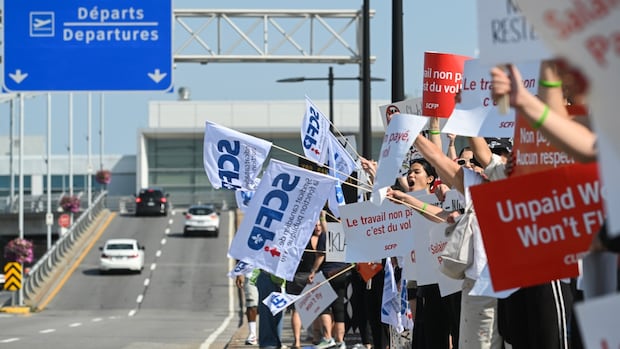In Tasha Ausman’s biology class, students raise caterpillars into monarch butterflies, then release them. In Grade 10 science, she has teens turning gears and cranks into mini feats of engineering.
For the final assessment of a recent forensics unit, the Gatineau, Que., teacher staged a mock crime scene, enlisted colleagues as witnesses and had students investigate the “vandalized” schoolyard shed to demonstrate what they’d learned.
Ausman knows how hands-on learning engages students and deepens understanding of the curriculum. But she’s worried that strict, sometimes murky “buy local” directives introduced amid tariff turmoil with the U.S. will hinder teachers from getting the supplies they rely on for students.
In March, the message that trickled down to Ausman and fellow educators in her board was that purchases must now come from in-province retailers with storefronts — an education ministry directive that had board officials telling schools their hands were tied, she said.
“I can’t walk into a store and buy a litre of certain chemicals or a bucket of frogs for dissection, or even some of the parts that we use for mandatory engineering projects,” Ausman pointed out, noting that some items aren’t available in Quebec or, if they are, may be much costlier due to the limited number of local suppliers.
Some orders that were en route this spring had to be cancelled after the buy-local directive came down, she said. “We had to change curricular plans part way through the year.”
Quebec teacher Tasha Ausman shares the science class materials, including frogs for dissection and gears for building, that she says she and her peers will have trouble sourcing under more restrictive procurement rules designed to support local businesses and avoid U.S. tariffs.
Procurement rules shift with U.S. tariff war
CBC News reached out to regional governments across Canada to ask if — given the recent context of new U.S. tariffs — they’ve changed procurement rules for schools to favour Canadian sources.
In late February, Quebec toughened public sector purchasing via online platforms, a further step in a pre-existing campaign to support local. In a statement to CBC, the government reiterated those tightened rules and noted that public bodies (including schools) “are required to favour Quebec goods, services and construction suppliers” for procurement below a certain dollar amount.
However, it indicated more latitude for purchases above a certain dollar amount, with public organizations “reminded to systematically favour Quebec and Canadian purchasing” and support “small businesses based in Quebec and elsewhere in Canada.”
But Ausman says the directive is still confusing for everyone from school board officials down to teachers themselves.
It “really puts the onus on boards, finance officers at the school and then teachers to decipher this language, when the business of our job isn’t really to decipher procurement strategies for the Ministry of Education,” she said.
Responses from other provinces and territories indicated flexibility in procurement policies.
Alberta and Manitoba, for instance, are urging school boards to prioritize local and Canadian suppliers, products and services, while Saskatchewan says school divisions “are encouraged to avoid any purchases from U.S. companies or of U.S. products, when it is possible.”
British Columbia says it’s axing U.S. purchases in favour of Canadian or non-American ones. The Northwest Territories is also doing that, and is prioritizing local outlets wherever possible.
PEI is encouraging school authorities to prioritize buying local, while Newfoundland and Labrador is committed to “supporting local and Canadian-made products where possible.”
Nova Scotia has limited how much schools can buy from American businesses. New Brunswick has barred new U.S. contracts (except goods or services deemed essential) and advised schools to consider alternative sources of supply.
Meanwhile, Ontario is restricting public bodies from buying American, with certain exceptions (urgent cases, for instance, or if a U.S. source is the sole option).

Buy-Canadian policies already established for some
Ontario’s directive came down in March just as several school boards voted to adopt buy-Canadian policies, though it’s generally an established practice, according to Stephanie Donaldson, Toronto-based executive director of the Ontario Public School Boards Association.
“Teachers, if they’re concerned, they should speak to their school board officials,” she said.
Donaldson feels provincial and school board procurement experts would help educators get the supplies they require “despite the challenges that we’re facing from the south.”
This buy-local push isn’t unreasonable at this fraught time, since “if it helps put dollars in the pockets of Canadian businesses … that’s a win,” said Mike Wake, superintendent of Alberta’s Wetaskiwin Regional Public Schools.
Yet the trick is how to make that happen, he said from Wetaskiwin, a small school division located south of Edmonton.

School purchasing must balance a host of factors, Wake explained, from “operational urgency” and legal considerations to “taking the public taxpayers’ dollar as far as we can [to support] student learning.”
He noted that schools getting what they need is different from grocery shopping solely for made-in-Canada items; sometimes, a U.S.-based student information system or American school bus supplier may be the best option.
“Our government’s been fantastic in saying ‘Do what you can,’ but with the understanding that there’s going to be some times that you aren’t going to necessarily always buy Canadian,” Wake said.
As anger over U.S. President Donald Trump’s trade war fuels a surging ‘Buy Canadian ’ movement, The National asks marketing professor Grant Packard to help navigate supply-line confusion so Canadians can keep their elbows up at the checkout line.
Back in Quebec, Ausman supports a less restrictive policy, since she already favours national vendors.
She’s worried that the hands-on learning labs she favours and other school offerings will be cut if teachers can’t obtain required materials — ranging from scientific specimens to student trumpets to laptops. That educators may feel forced to pay out of pocket for supplies themselves is also a concern.
Ultimately, she wants decision-makers to put more consideration into where cash-strapped boards can source what they need.
“If you’re going to intervene in the spending and the procurement, you have to also provide a solution to the problem,” she said.








